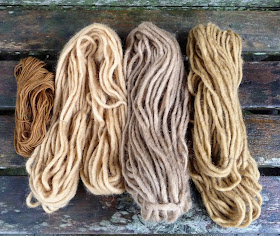In February, the purple male catkins are formed, though no leaves yet. After fermenting for a week, the water in the bucket of alder became acidic, pH 5. Transferred to a pot and simmered for an hour, left overnight then sieved through a colander, the dye bath looked a rich red-brown. Adding iron turned the fluid black, copper made it dark brown.
I dyed 250g chunky Cheviot wool and 25g merino yarn by simmering them for an hour in the straightforward alder dye pot and leaving them to soak overnight. Here they are, while still damp. I expected the merino would take up much deeper colour and was just grateful the Cheviot went a decent fawn, as I wanted to use it for knitting a bag. Two of the 50g skeins of dyed Cheviot were modified by a short simmer, one in half the original dye bath with a slug of iron water added, the other in the remaining half with copper solution. This picture shows, from the left, the unmodified alder dye on merino and then Cheviot, iron modified Cheviot, then copper modified Cheviot wool.
Deciding the copper gave the best colour, I modified the big 100g skein of dyed Cheviot too, then dyed two fresh 50g skeins in the two afterbaths, getting pale colours which I hoped would make a good contrast for helix stripe knitting. Once the bag was finished, I felted it by washing at 95 degrees Centigrade in the washing machine. Because washing powder is alkaline, the alder dye colours shifted.
Though the colours came out of the wash stronger, alkali modification reduced the contrast between the helix bands. Overall, I am pleased to have greater depth of colour and well chuffed with the bag, which has proved sturdy and functional during a fortnight's constant use while travelling. The Cheviot has bloomed and pilled a bit since this photo was taken and among the wool yarns I have tried, it certainly doesn't take up dye brilliantly. Nonetheless, I'll be happy enough to use up my last 400g Cheviot to make another bag. Can't resist finishing with a holiday snap from Tacoma. I had the best time, great people in such a hip cool gritty city. Listen to this - Stephanie Anne Johnson, she is even better live.








I can't help expecting reddish colour from alder bark though I never got it. The beige-browns I actually got in two or three experiments discouraged me from trying again.
ReplyDeleteThe inner bark does go red when exposed to air, have to agree you would think that colour ought to show up in the dye. Still, alder needs no mordant and is readily available all year round, so I might experiment some more.
DeleteOverdye with indigo. Makes a beautiful olive/blue colour.
DeleteAbsolutely!
DeleteInteresting colours. I tried birch bark once, well worth trying, especially the inner bark which should give you the reddish hues
ReplyDeleteI only got pink from birch bark, but I blame the Cheviot ..
Delete